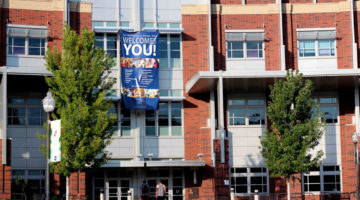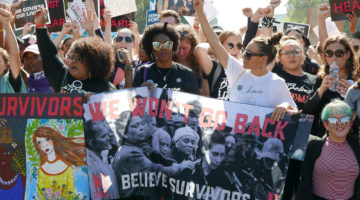By Maddison Cervantes
A Sexual Conduct and Campus Safety Survey provided by the Student Services Division at the University of Nevada, Reno stated that as of November 2014, 651 students self-identified as victims of sexual assault, and 201 students as perpetrators.
The survey invited all university students to share their experiences anonymously. The results have been processed and categorized to help further understand and prevent sexually violent occurrences.
Jennifer Lowman, coordinator of Student Persistence Research at the university, presented the survey’s findings at an open forum held last Thursday, Feb. 5 in the Joe Crowley Student Union Theatre.
Lowman explained the categories used to organize the data to provide the audience with insight on how the survey operated.
The survey consisted of 20 questions from four categories: the role of alcohol, perpetration, bystander experiences and victim prevalence.
“We asked [participants] questions about alcohol such as, ‘were you drinking the last time you had intercourse?’ to sort of get an idea of how much alcohol facilitates sex,” Lowman said. “Then we asked, in the perpetrator section, if [participants] have ever fondled, groped, attempted or completed oral sex or penetration against an unwilling student.”
In the victim prevalence section, victims identified if they have experienced unwanted sexual contact, but Lowman said that because sexual violence is a broad category, students can interpret certain instances differently than others. Therefore, the questions were phrased in a manner that would encourage a variety of responses.
Lowman noted that sexual assault, legally, is very narrowly defined, and students may experience much more than what might qualify in the legal definition.
“We didn’t ask them just about rape, but about sexual violence very broadly,” Lowman said. “We did that because there are many behaviors that go into sexual violence, and we don’t want to minimize what someone might see as a less severe behavior.”
Rape myths, excuses or sources of blame used by a perpetrator, were also a focus of the survey. It was found that students are not likely to endorse rape myths.
Examples of these myths given in the survey include, ‘If a weapon is not involved, it’s not rape,’ ‘If alcohol is involved, it’s not rape,’ and, ‘Some people are just asking for it.’
Lowman stated that nationwide, the endorsement of such rape myths has gone down over the last several decades because students have learned that they are not accurate.
“But we still identify differences — we know there is higher endorsement for these items among men, especially fraternity men, but also students who think that alcohol facilitates sexual opportunities, and perpetrators,” Lowman said.
The last questions in the survey asked students if they had ever unwilling fondled, groped, attempted penetration or oral sex, completed penetration or oral sex on another person or been the unwilling receptor of such actions. Answers to these questions were organized and separated into numbers that Lowman released to the audience.
Survey results showed that 3 percent of the survey participants self-identified in engaging in at least one of the five acts. One hundred twenty two participants were men and 79 were women. Eleven percent of the participants identified as victims, 540 women and 111 men. Approximately 80 percent of the victims knew their perpetrator.
Along with these statistics, the locations of 92 sexual assaults were in the residence halls or somewhere else on campus, 42 were in a fraternity house and 518 were off campus.
When Lowman concluded her presentation, Vice President for Student Services Shannon Ellis discussed available programs such as Green Dot and I STAND that offer sexual awareness training and a safer outlook, on-campus workshops and other plans of action.
The meeting was then opened up to the audience for questions and commentary. Attendees raised the question, ‘Now that we have this information, what’s next?’
Lowman and Ellis reassured audience members that resources are in the works to be provided in the future such as a victim advocate position that has been posted and will be an available resource for faculty, staff and students, a sexual violence case manager and a possible option for anonymous reporting on campus.
Sophomore Marissa Harrington, a representative for I STAND, a campus organization that stresses the importance of openly discussing what ‘respectful and healthy sexual conduct’ means, responded to concerns about students becoming actively involved in a sexual violence prevention ‘culture.’
Harrington stated that such a culture cannot be established without students having the motivation to help. Currently, anti-sexual assault programs and seminars are hosted by the university and made mandatory to multiple Greek organizations. Herrington sees a problem with the required attendance, and does not believe that it is beneficial to the culture being aimed for.
“The thing with frat guys and sorority girls is that they are being persuaded to go to anti-sexual violence programs and being offered community service hours for going,” Harrington said. “People have to want to be involved in this, it has to affect them to a point where they care to be involved.”
Other audience members raised concerns about the reporting of sexual violence cases, and that many are not sure how to go about these incidences.
Green Dot representative Justine Hernandez stated that in many cases, it is true that situations containing sexual violence can be difficult to handle, but assistance is available. Green Dot is a nationwide organization that acts to prevent violence, and trains those interested in how to effectively handle violent situations.
“[Students] see witness these sexually violent situations where their gut is telling them to do something, but what?” Hernandez said. “‘Is it even a problem?’ ‘Am I overreacting?’ There are so many internal dialects that go on, and the beauty of Green Dot is that we go over all of that: what the problem is, how to identify it, we practice skills so that the minute you leave the room, you’re completely prepared for anything that could happen.”
The awareness of sexual violence on campus is a work in progress, and the blueprints have become a plan of action. The data and results from the survey can be found online at unr.edu/beheard, along with the new resources in store to create a safer and more aware campus.
Maddison Cervantes can be reached at mcervantes@sagebrush.unr.edu and on Twitter at @madcervantes.











